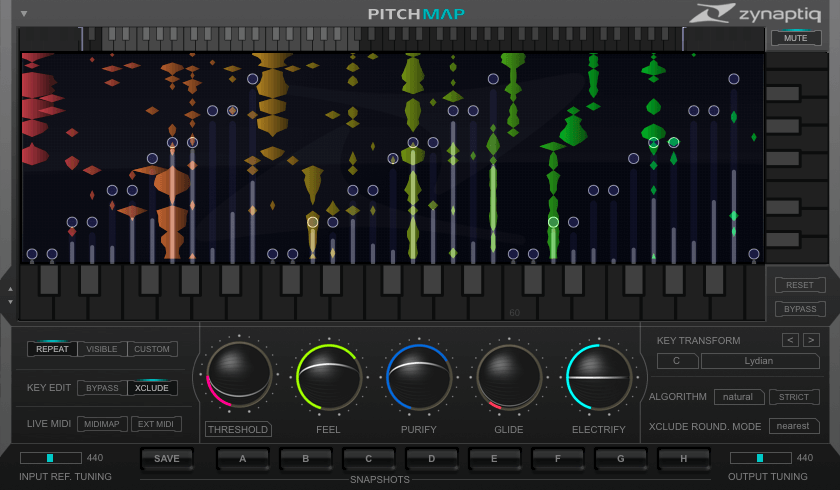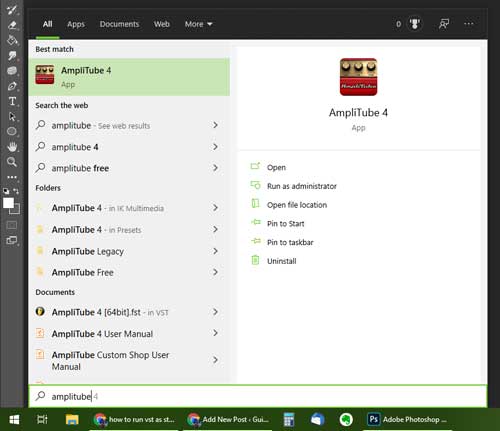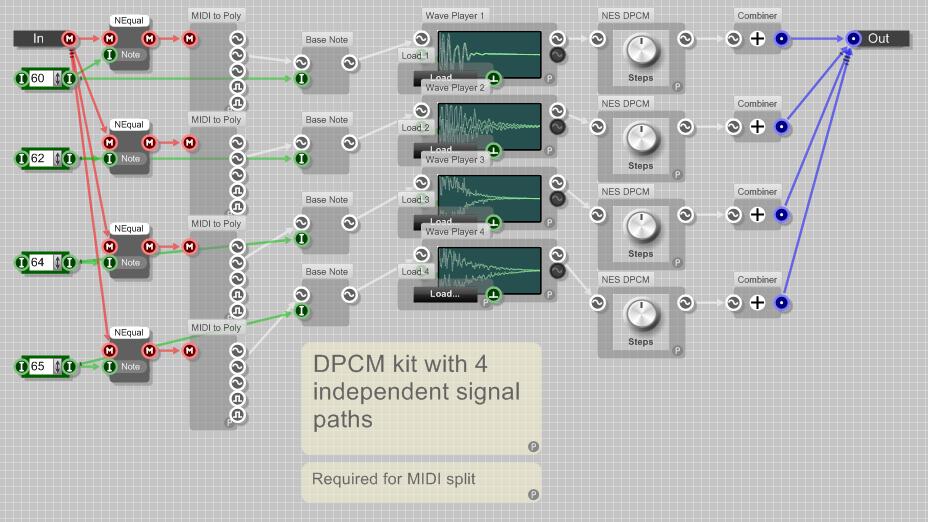Plugins VSTi - VSTi (Virtual Studio Technology) is a plug-in format which you can use in conjunction with any compatible host application (see the Hosts - VST category). The large majority of VST Instruments are software synthesizers, however there are also many samplers and drum machines. You may also like to check out our editor's pick of the.
32-bit plug-ins on 64-bit Windows: C:Program Files (x86)Common FilesVST2. Any other folder your VST host application is scanning during startup by default is also suitable. But, to keep plug-in installations independent from a specific VST host release, never install plug-ins into the program folder of the VST host application or any other. NES-chip emulation Famisynth 2 by MU-Station is a Nintendo Entertainment System (NES/Famicom) sound chip emulation. The free chip vst plugin features a sound generator (4-bit or 8-bit) with 5 waveforms + a waveshaper, an ADSR-envelpe, and a modulation generator where you can affect the wave, speed, depth and delay of the sound.
These are the best free chiptune vst synths. If you're looking for some free synths that make those low bit style sounds, the 5 in this post are going to get you the results you're after.
The free synths in this list make sounds similar to what the NES, Atari, Game Boy, and even the Commodore 64 make. From percussion to sound effects, keep reading until the end for a bonus.
Chart of the best free synths for chiptune
This table includes all of the free synths for chiptune that are mentioned in the article below.
| Synth Name | Available Plugin Formats | Supported OS |
|---|---|---|
| PULS | 32-bit VST | Windows |
| NES Pulse VST | 32-bit VST | Windows |
| ymVST | 32-bit VST | Windows |
| pooBoy 2 | 32-bit VST | Windows |
| 38911 Bytes | 32-bit VST | Windows |
1. PULS
First up, we've got a Monophonic pulse wave synth with a really simple design. The synth only has buttons (32 to be exact), but hey, this plugin can definitely make some noise.
Get it here: PULS synth free download
2. NES VST PACK
This next one is a Nintendo Entertainment System sound emulator pack with 3 different plugins.
They are for creating pulse waves (NESPulse), triangle waves (NESTri), and white noise (NESNoise).
Together, these really hit the mark when it comes to recreating the original sounds of the console.
Just press the pink 'ZIP' button to the right of the option once you're on the download page.
Get it here: NES VST PACK synth bundle - free download
3. ymVST
Based on Atari ST sound chip, ymVST even has a pixel themed interface. You'll get a lot of those old-school sounds from this plugin.
Get it here: ymVST synth free download
4. pooBoy 2
This one from Pontonius is an emulation of the sounds from the original Game Boy. Sure, it's got a silly name but, love it or hate it, this thing does its job. It has that retro look while still keeping it user-friendly.
Get it here: pooBoy 2 synth free download
5. 38911 Bytes
Based on Commodore 64, this classic looking synth made by Odo Synths sticks to a traditional interface. You might be intimidated by its looks, but really, after figuring out what everything does, you should be good to go.
Get it here: 38911 Bytes synth free download
(Press the pink 'ZIP' button on the top right of the plugin bar)
Now, these are definitely not all of the free plugins for Chiptune out there, they really only scratch the surface. After combing through many lists, these are the ones I found to be most promising.

I hope you enjoyed the list and if you did, share this with a friend. Thanks for reading!

Virtual Studio Technology (VST) is an audio plug-in software interface that integrates software synthesizers and effects units into digital audio workstations. VST and similar technologies use digital signal processing to simulate traditional recording studio hardware in software. Thousands of plugins exist, both commercial and freeware, and many audio applications support VST under license from its creator, Steinberg.
Overview[edit]
VST plugins generally run within a digital audio workstation (DAW), to provide additional functionality, though a few standalone plugin hosts exist which support VST. Most VST plugins are either instruments (VSTi) or effects (VSTfx), although other categories exist—for example spectrum analyzers and various meters. VST plugins usually provide a custom graphical user interface that displays controls similar to physical switches and knobs on audio hardware. Some (often older) plugins rely on the host application for their user interface.
VST instruments include software simulation emulations of well-known hardware synthesizers and samplers. These typically emulate the look of the original equipment as well as its sonic characteristics. This lets musicians and recording engineers use virtual versions of devices that otherwise might be difficult and expensive to obtain.
VST instruments receive notes as digital information via MIDI, and output digital audio. Effect plugins receive digital audio and process it through to their outputs. (Some effect plugins also accept MIDI input—for example, MIDI sync to modulate the effect in sync with the tempo). MIDI messages can control both instrument and effect plugin parameters. Most host applications can route the audio output from one VST to the audio input of another VST (chaining). For example, the output of a VST synthesizer can be sent through a VST reverb effect.
History[edit]
Steinberg released the VST interface specification and SDK in 1996. They released it at the same time as Steinberg Cubase 3.02, which included the first VST format plugins: Espacial (a reverb), Choirus (a chorus effect), Stereo Echo, and Auto-Panner.[2]
Steinberg updated the VST interface specification to version 2.0 in 1999. One addition was the ability for plugins to receive MIDI data. This supported the introduction of Virtual Studio Technology Instrument (VSTi) format plugins. VST Instruments can act as standalone software synthesizers, samplers, or drum machines.[3]
Neon[4] was the first available VST Instrument (included with Cubase VST 3.7). It was a 16-voice, 2-oscillator virtual analog synthesizer.[3]
In 2006, the VST interface specification was updated to version 2.4. Changes included the ability to process audio with 64-bit precision.[5] A free-software replacement was developed for LMMS that would be used later by other free-software projects.[6][7]
VST 3.0 came out in 2008. Changes included:[8]
- Audio Inputs for VST Instruments
- Multiple MIDI inputs/outputs
- Optional SKI (Steinberg Kernel Interface) integration
VST 3.5 came out in February 2011. Changes included note expression, which provides extensive articulation information in individual note events in a polyphonic arrangement. According to Steinberg, this supports performance flexibility and a more natural playing feel.[9]
In October 2011, Celemony Software and PreSonus released Audio Random Access (ARA), an extension for audio plug-in interfaces, such as VST, allowing greater integration between audio plug-ins and DAW software.[10]
In September, 2013, Steinberg discontinued maintenance of the VST 2 SDK. In December, Steinberg stopped distributing the SDK.[11] The higher versions are continued.
VST 3.6.7 came out in March, 2017. It includes a preview version of VST3 for Linux platform, the VST3 part of the SDK gets a dual license: 'Proprietary Steinberg VST3' or the 'Open-source GPLv3'.
As VSTi virtual instrument technology was under development at Steinberg, a platform for virtual instruments using DirectX engine technology was being developed by Cakewalk, famous for its Sonar DAW. However, the format did not gain much acceptance beyond instruments bundled with SONAR. Currently, almost all virtual instruments on the market use Steinberg's VSTi format.[citation needed]
VST plugins[edit]
There are three types of VST plugins:
- VST instruments generate audio. They are generally either Virtual Synthesizers or Virtual samplers. Many recreate the look and sound of famous hardware synthesizers. Better known VST instruments include Discovery, Nexus, Sylenth1, Massive, Omnisphere, FM8, Absynth, Reaktor, Gladiator, Serum and Vanguard.
- VST effects process rather than generate audio—and perform the same functions as hardware audio processors such as reverbs and phasers. Other monitoring effects provide visual feedback of the input signal without processing the audio. Most hosts allow multiple effects to be chained. Audio monitoring devices such as spectrum analyzers and meters represent audio characteristics (frequency distribution, amplitude, etc.) visually.
- VST MIDI effects process MIDI messages (for example, transpose or arpeggiate) and route the MIDI data to other VST instruments or to hardware devices.
Snes Vst
VST hosts[edit]
A VST host is a software application or hardware device that VST plugins run under. The host application presents the plugin UIs and routes digital audio and MIDI to and from the plugins.
Software[edit]
Many VST hosts are available. Not all of these support VST 3 plugins.
- Acon Digital Acoustica
- Acoustica Mixcraft (VST3)
- Ardour (open source)
- Audacity (free and open source, VST support works on Windows, Mac OS X and Linux[12])
- Digital Performer (version 8 or higher)
- Psycle (open source)
- Reason (partially implemented in version 9.5 or higher)
- vMix (VST3 Only)
Stand-alone dedicated hosts provide a host environment for VST plugins rather than use the plugins to extend their own capabilities. These are usually optimized for live performance use, with features like fast song configuration switching.

VST plugins can be hosted in incompatible environments using a translation layer, or shim. For example, FL Studio only supports its own internal plugin architecture, but an available native 'wrapper' loads VST plugins, among others. FXpansion offers a VST-to-RTAS (Real Time AudioSuite) wrapper that lets VST plugins run in Pro Tools, and a VST-to-Audio Units wrapper lets VST plugins run in Logic Pro.
Hardware[edit]
Hardware VST hosts can load special versions of VST plugins. These units are portable and usable without a computer, though some of them require a computer for editing. Other hardware options include PCI/PCIe cards designed for audio processing, which take over audio processing from the computer's CPU and free up RAM.
Some hardware hosts accept VSTs and VSTis, and either run Windows-compatible music applications like Cubase, Live, Pro Tools, Logic etc., or run their own DAW. Other are VST Hosts only and require a separate DAW application. Origin from Arturia is a hardware DSP system that houses several VST software synthesizers in one machine, like Jupiter 50/80 from Roland. Using appropriate software, audio data can also be sent over a network, so the main host runs on one computer, and VST plugins on peripheral machines.
Standard[edit]
The VST plugin standard is the audio plugin standard created by Steinberg to allow any third-party developers to create VST plugins for use within VST host applications. VST requires separate installations for Windows, Mac OS X and Linux. The majority of VST plugins are available for Windows only due to Apple's competing proprietary Audio Unit technology being used on OS X (Audio Units is a core part of the OS X operating system). The short history of commercial environments for Linux means few developers have targeted this platform.
Presets[edit]
VST plugins often have many controls, and therefore need a method of managing presets (sets of control settings).
Steinberg Cubase VST introduced two file formats for storing presets: an FXP file stores a single preset, while an FXB file stores a whole bank of presets. These formats have since been adopted by many other VST hosts, although Cubase itself switched to a new system of preset management with Cubase 4.0.
Many VST plugins have their own method of loading and saving presets, which do not necessarily use the standard FXP/FXB formats.

Competing technologies[edit]
- Apple's Audio Units
- Avid's Avid Audio eXtension
- Digidesign's Real Time AudioSuite
- Digidesign's TDM
- LADSPA, DSSI for Linux
- LV2, a cross-platform, open source, liberally licensed audio plugin standard
- Microsoft's DirectX plugin
- Mark of the Unicorn's Motu Audio System
- JACK Audio Connection Kit, an open-source sound server allowing flexible audio routing between apps
- Reason Studios' Rack Extensions
Programming languages[edit]
Steinberg's VST SDK is a set of C++ classes based around an underlying C API. The SDK can be downloaded from their website.
There are several ports available, such as a Delphi version by Frederic Vanmol,[13] a Java version from the jVSTwRapper project at Sourceforge,[14] and two .NET versions – Noise[15] and VST.NET;[16] this open source project also includes a framework that makes creating VST plugins easier and result in more structured code. VST.NET also provides support for writing managed host applications with a managed class that allows loading an unmanaged Plugin. A notable language supporting VST is FAUST, considering that it is especially made for making signal processing plugins, often producing code faster than hand-written C++.
In addition, Steinberg has developed the VST GUI, which is another set of C++ classes, which can be used to build a graphical interface. There are classes for buttons, sliders and displays, etc. Note that these are low-level C++ classes and the look and feel still have to be created by the plugin manufacturer. VST GUI is part of the VST SDK and is also available as a SourceForge project.[17]
Many commercial and open-source VSTs are written using the Juce C++ framework instead of direct calls to the VST SDK because this allows multi-format (VST, Audio Units and Real Time AudioSuite) binaries to be built from a single codebase.
Nintendo Vst
See also[edit]
- LADSPA and LV2, similar open-source standards.
- SynthEdit, a VST/VSTi editor.
References[edit]
- ^'Our Technologies'. www.steinberg.net.
- ^Steinberg Cubase 3 (article), Sound on sound, Jul 1996.
- ^ abCubase 3.7 (article), Sound on sound, Sep 1999
- ^KVR audio.
- ^Steinberg.
- ^'vestige.h'.
- ^'aeffectx.h'.
- ^News, KVR audio.
- ^VST 3.5 a milestone in VST development (News), Steinberg, 2011-02-10.
- ^'Celemony introduces ARA Audio Random Access - Extension for Plug-in Interfaces'. KVR Audio. Retrieved 2018-06-05.
- ^SDK for VST 2 software interface discontinued (News), Steinberg, 2013-12-09
- ^VST plug-ins
- ^VST, Axi world.
- ^jVSTwRapper, Source forge.
- ^Noise, Google code.
- ^VST.Net, Codeplex.
- ^http://sourceforge.net/projects/vstgui